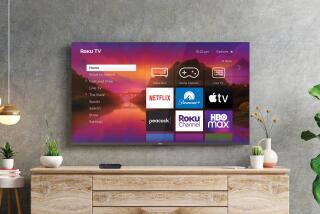Roku, a streaming fixture, gets a lift from home-viewing surge

MILLBRAE, Calif. — Roku Inc., whose digital media technology helped usher in the streaming revolution more than a decade ago, is getting a significant lift from the surge in home entertainment viewing.
Until recently, the San Jose-based company had confronted doubts among many investors that it could compete with new and large rivals in the fiercely competitive streaming space.
For the record:
11:38 a.m. May 15, 2020
An earlier version of this story included an estimate that Amazon shipped
51.8 million streaming connected devices in the first quarter. That number was actually an estimate of how many Amazon devices were installed globally as of the first quarter.
But Roku’s fortunes have brightened considerably since the COVID-19 pandemic halted production in Hollywood and confined people to their homes.
Like other streamers, Roku has seen a big rise in consumers using its platform to view more than 500,000 TV shows and movies from subscription services like Netflix or Disney+, or through free, ad-supported channels like Roku’s own streaming channel.
Roku recently disclosed that across its platform users streamed a record 13.2 billion hours during the first quarter, up nearly 50% over the same period a year ago. Streaming hours jumped 80% in April alone as many people were sheltering at home and looking for ways to entertain themselves.
“This is already going to be a huge year for streaming with so many great services launching, and if anything, the current environment is just accelerating that transition,” said Rob Holmes, Roku’s vice president of programming. “We’re in week nine now of everyone sheltering at home, with streaming becoming much more a critical part of their day-to-day experience.”
Investors have taken note. Roku’s stock, which closed Thursday at $116.60, has jumped more than 80% since falling to a 52-week low in mid-March, when governments ordered stay-at-home measures to curb the spread of the virus.
“Many factors suggest Roku/OTT will emerge from COVID-19 much stronger,” wrote Jason Helfstein, head of internet research at Oppenheimer & Co. in a recent note. He has a buy on Roku stock.
Michael Pachter, a managing director with Wedbush Securities, who is neutral on Roku stock, said the crisis will delay but not derail Roku’s path to profitability. “But if they convert another 10 million people ... then they are ultimately going to capitalize on that when the economy does recover,” he said.
Roku is uniquely positioned to benefit from the upswing in home viewing because it has many hooks into the streaming ecosystem. Roku dominates the U.S. market for streaming connected devices, with an install base of 35.8 million, beating larger tech giants Amazon, Google and Apple, according to Kagan, the media research unit of S&P Global Market Intelligence. Roku’s platform is installed in nearly one in three U.S. smart TVs, helped by the rapid acceleration of cable cord-cutting.
In addition to selling streaming players, Roku also licenses its technology to TV manufacturers and gets a cut of subscriptions or programs sold through its service. Additionally, the company makes a growing amount of money selling ads across its platform and on its free streaming channel.
Roku generated an estimated $528.4 million in advertising revenue last year, up 82% from 2018, according to research firm eMarketer.
To be sure, the pandemic has significantly weakened the advertising market, which will likely slow Roku’s growth this year.
Executives acknowledged as much in a call with analysts last week. They predicted ad sales will grow in 2020, but at a slower pace. The company reported a net loss of $54.6 million on revenues of $321 million in the first quarter, reflecting higher compensation costs and other charges. Revenues were up 55% from a year ago and exceeded analyst expectations.
Roku executives argued that they were well positioned to ride out the storm and would benefit once the economy improves because of the company’s consumer-friendly technology and the partnerships they’ve built.
“While advertisers are spending less, reduced budgets mean marketers are looking for ways to invest more effectively and this should accelerate the shift to streaming ad buys,” Roku CEO Anthony Wood told analysts.
From Walmart to Google, brands have had to adapt their advertising messages to convey more empathy with consumers during the coronavirus crisis.
Roku has come a long way from 2002, when it was founded by the entrepreneur. Wood named it after the number “6” in Japanese because it was the sixth company that he had started.
Wood and his team had developed a connected TV device within Netflix when CEO Reed Hastings decided not to move forward with it.
Roku later brought the player to market in 2008.
Over time, the company expanded its platform to include many streaming channels. In 2017, Roku became a publicly traded company and started its own streaming hub called the Roku Channel, which offers free ad-supported shows and movies (Roku does not produce its own programming).
In January 2019, Roku partnered with other channels like Epix and Starz to market their subscription programs on the Roku Channel. Roku gets a cut of the subscription revenue if consumers sign up for third-party services on its platform.
Courtney Menzel, Epix’s executive vice president and co-general manager, said that it’s important that consumers can discover Epix in a variety of ways and the Roku Channel has a large built-in audience.
“They have also been great partners in finding ways to curate and merchandise our content … so Epix is easily discoverable and accessible to subscribers in this crowded marketplace,” Menzel said in a statement.
The coronavirus has ended big budget brand deals for some influencers, but the focus has shifted to engaging with a potentially bigger audience more authentically.
Roku, previously based in Los Gatos, moved into its new San Jose headquarters last year. The company, which has about 1,650 employees who have been working from home during the pandemic, has offices throughout the U.S., including a 100-person staff in Santa Monica.
As the company grows, however, it faces formidable competition from such rivals as Amazon and Comcast that are angling to grab market share.
“I’d try as much as I could to build a wall around my business model,” said Jeff Wlodarczak, a principal and senior analyst at Pivotal Research Group, who has a “sell” rating on Roku stock. “The problem is, no wall is insurmountable when you are competing against Amazon or Google and now Comcast and Charter. These are massive companies.”
While Roku dominates the U.S. market, it represents a smaller amount of connected streaming device shipments worldwide, according to Kagan. In the global market, Amazon shipped 3.9 million streaming connected devices in the first quarter, compared with Roku’s 2.6 million, Kagan said.
The company is already selling its players in markets including the United Kingdom, France, Canada and Mexico. But some analysts say that Roku needs to move faster in its expansion abroad.
Roku executives said they are committed to growing globally during the pandemic.
“Although the streaming decade began differently than anyone could have imagined, we are confident the fundamental shift to streaming will continue, perhaps even faster than previously expected,” Wood told shareholders.
More to Read
Inside the business of entertainment
The Wide Shot brings you news, analysis and insights on everything from streaming wars to production — and what it all means for the future.
You may occasionally receive promotional content from the Los Angeles Times.











